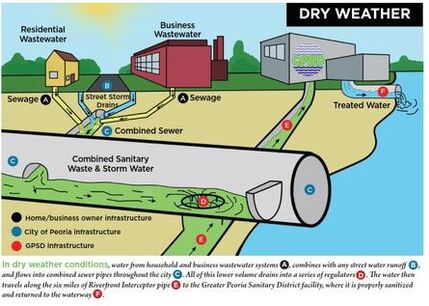Cleaner River Project
|
Estimated 10-Year Capital Investment: $32M
|
The Greater Peoria Sanitary District (GPSD) provides wastewater disposal and treatment for much of the Greater Peoria area. Formed in 1927, GPSD originally built infrastructure to collect sewage from areas along the Illinois riverfront, including the City of Peoria's combined sewer system, into a large pipe (called the Riverfront Interceptor) and convey that sewage to GPSD's wastewater treatment plant on Darst Street.
As GPSD's infrastructure in this area approaches the 100-year-old mark, improvements will be necessary for urban renewal and in compliance with a joint settlement with the United States Environmental Protection Agency (USEPA), Illinois Environmental Protection Agency (IEPA), and the City of Peoria for increased environmental protection. |
Riverfront Interceptor (c. early 1930s)
|

WHAT IS A COMBINED SEWER SYSTEM?
Like many communities, the City of Peoria owns a combined sewer system, which dates back to the 1800s. Combined sewer systems collect and convey wastewater and stormwater in a single pipe. Before GPSD was formed, this water flowed directly into the Illinois River.
Today, under normal dry weather conditions, all sewage is collected and carried through GPSD's Riverfront Interceptor to the GPSD wastewater plant for treatment. The Riverfront Interceptor captures more than just City of Peoria sewage. It also captures Peoria Heights and much of West Peoria.
Like many communities, the City of Peoria owns a combined sewer system, which dates back to the 1800s. Combined sewer systems collect and convey wastewater and stormwater in a single pipe. Before GPSD was formed, this water flowed directly into the Illinois River.
Today, under normal dry weather conditions, all sewage is collected and carried through GPSD's Riverfront Interceptor to the GPSD wastewater plant for treatment. The Riverfront Interceptor captures more than just City of Peoria sewage. It also captures Peoria Heights and much of West Peoria.

WHAT IS COMBINED SEWER OVERFLOW, AND WHY IS IT A PROBLEM?
Sometimes during and after a rain or snow melt, stormwater overwhelms the system and a combination of stormwater and sewage is released into the Illinois River via the City’s overflow pipes. This situation is called a Combined Sewer Overflow (CSO). Without this ability to spill over, sewage would back up into basements and streets.
In addition to the obvious reasons for why raw wastewater should not flow into the Illinois River, the federal Clean Water Act also makes it unlawful to discharge pollutants from sewer systems into U.S. waterways. Therefore, action is necessary.
Sometimes during and after a rain or snow melt, stormwater overwhelms the system and a combination of stormwater and sewage is released into the Illinois River via the City’s overflow pipes. This situation is called a Combined Sewer Overflow (CSO). Without this ability to spill over, sewage would back up into basements and streets.
In addition to the obvious reasons for why raw wastewater should not flow into the Illinois River, the federal Clean Water Act also makes it unlawful to discharge pollutants from sewer systems into U.S. waterways. Therefore, action is necessary.
|
WHAT IS REQUIRED TO ADDRESS THIS ISSUE?
The City of Peoria and GPSD have been in discussions with the USEPA and IEPA for many years to determine how to reduce the number of CSOs to as close to zero as possible. Because GPSD owns infrastructure connected to the combined sewer system (the Riverfront Interceptor, various regulator structures, and the wastewater plant), GPSD’s participation is necessary toward resolving the CSO issue. GPSD has worked collaboratively with the City of Peoria to determine cost-effective ways of improving the GPSD system to attempt to capture more water. While the City of Peoria will be responsible for meeting its obligations to reduce CSOs due to its ownership of the combined sewer system, GPSD will clean its Riverfront Interceptor pipe, enlarge regulators, and connection pipes to the Riverfront Interceptor, and make other improvements (such as adding control gates) aimed at allowing more water to reach the treatment plant. These projects and timelines are detailed to the right. Additionally, as part of the USEPA and IEPA discussions but unrelated to CSO, GPSD will enlarge two wet-weather facilities in Bartonville for better system performance by January 1, 2030. |
GPSD's Projects and Deadlines
By January 1, 2026:
By January 1, 2029:
By January 1, 2032:
Deadline TBD:
|
|
WILL THESE PROJECTS IMPACT GPSD'S SEWER RATES?
Fortunately, GPSD has anticipated some of this work for many years, and has already modestly increased its rates for the last several years to start a reserve fund to help minimize future increases. GPSD intends to also utilize favorable debt financing and will aggressively seek grants. The City of Peoria's sewer charges are separate from GPSD's sewer charges. They are currently billed by GPSD on the City's behalf and are set by the Peoria City Council. Additionally, GPSD is not responsible for and does not collect the City's stormwater utility. |
|

